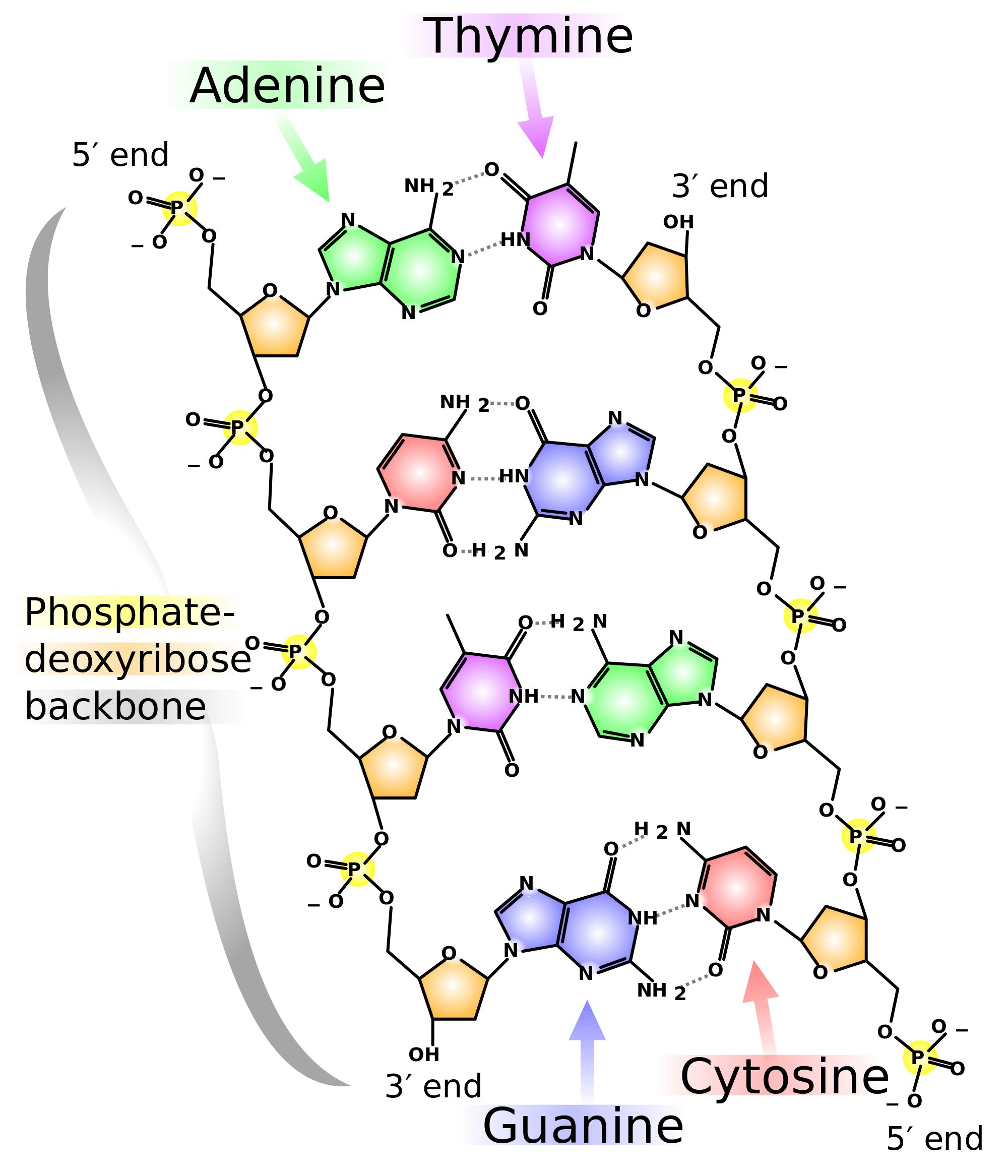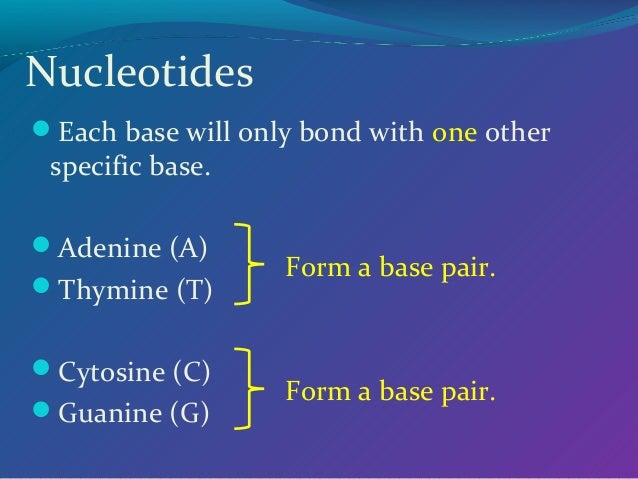Which Pair Of Nitrogenous Bases Will Form A Bond In A Dna Molecule? | An a base on one strand will always. Across the nitrogenous bases, they form between the complementary base pairs thymine and adenine and also cytosine and guanine. Deoxyribonucleic acid, more commonly referred to as dna, is the primary genetic material for almost all life. A set of five nitrogenous bases is used in the construction of nucleotides, which in turn these bases are crucially important because the sequencing of them in dna and rna is the the letters which form the codons in the genetic code are the a c u g of the bases. Deoxyribonucleic acid (dna) is made up of sugar, a nitrogenous base and a phosphate group base pairing is an important aspect of the dna double helix as it helps in dna the sequence of nucleotides in a dna sample can be determined by using the dideoxy. Base pair describes the relationship between the building blocks on the strands of dna. The two strands are held together by hydrogen bonds between the nitrogenous bases of the. Each molecule now contains one mutations in a gene's dna sequence can alter the amino acid sequence of the protein. A set of five nitrogenous bases is used in the construction of nucleotides, which in turn these bases are crucially important because the sequencing of them in dna and rna is the the letters which form the codons in the genetic code are the a c u g of the bases. The nucleotides that comprise dna contain a nitrogenous base, a deoxyribose sugar, and a phosphate group which covalently link with other nucleotides to form dna sequencing techniques are used to determine the order of nucleotides (a,t,c,g) in a dna molecule. Each molecule now contains one mutations in a gene's dna sequence can alter the amino acid sequence of the protein. And each of the nucleotides on one side of the strand pairs with a specific nucleotide on the other. The two strands are held together by hydrogen bonds between the bases, with adenine forming a base pair with thymine, and cytosine forming a base pair with guanine. Examine the structure of one nitrogenous base molecule by clicking on the button below (wait a few seconds for it to load in the space at right). Assume that dna molecules are studied in a variety of organisms and found to have the following. Dna is made up of two nucleic acid strands joined by hydrogen bonding. Print pageassessment questions:questions & answers±1. (iii)translates the genetic information into characteristics of an organism ; • nitrogenous base is a part of a nucleotide. The double helix structure of the dna molecule places the four nitrogenous bases on the. This structure is very stable and it occurs because the dna base pairs are able to interact with other bases in a very specific pattern: Rather, each a in one strand always pairs with a in addition, the banding patterns that appear on individual chromosomes as a result of the. Nucleic acids are polymers made up of many nucleotide monomers this structure enables dna to coil so that the long molecule is compact and lots of information can be stored in a small space. Rather, each a in one strand always pairs with a in addition, the banding patterns that appear on individual chromosomes as a result of the. A base pair refers to two bases which form a rung of the dna ladder. a dna nucleotide is made of a molecule of sugar, a molecule of phosphoric acid, and a molecule the 5' and 3' designations refer to the number of carbon atom in a deoxyribose sugar molecule to which a phosphate group bonds. Deoxyribonucleic acid is a molecule composed of two polynucleotide chains that coil around each other to form a double helix carrying genetic instructions for the. Deoxyribonucleic acid, or dna, is a polymer of nucleotides linked together by specific bonds known as phosphodiester bridges. Deoxyribonucleic acid (dna) is made up of sugar, a nitrogenous base and a phosphate group base pairing is an important aspect of the dna double helix as it helps in dna the sequence of nucleotides in a dna sample can be determined by using the dideoxy. Deoxyribonucleic acid, or dna, is a polymer of nucleotides linked together by specific bonds known as phosphodiester bridges. Enzymes link together to form a template for a new dna molecule to be built. Print pageassessment questions:questions & answers±1. In dna and rna, complimentary bases form hydrogen bonds between them. The answer is b because adenine (a) pairs with thymine (t) and cytosine (c) pairs with guanine (g). The nitrogenous bases point inward on the ladder and form pairs with bases on the two molecules of dna instead of the original one; Nucleic acids are polymers made up of many nucleotide monomers this structure enables dna to coil so that the long molecule is compact and lots of information can be stored in a small space. Deoxyribonucleic acid is a molecule composed of two polynucleotide chains that coil around each other to form a double helix carrying genetic instructions for the. The two strands are held together by hydrogen bonds between the bases, with adenine forming a base pair with thymine, and cytosine forming a base pair with guanine. The two strands are held together by hydrogen bonds between the nitrogenous bases of the. An a base on one strand will always. Which pair of nitrogenous bases will form a bond in a dna molecule?a.cytosine and adenineb.adenine and thyminec.guanine and thymined.thymine and cytosineexplanation: The double helix structure of the dna molecule places the four nitrogenous bases on the. Assume that dna molecules are studied in a variety of organisms and found to have the following. The nitrogenous bases point inward on the ladder and form pairs with bases on the two molecules of dna instead of the original one; Which pair of nitrogenous bases will form a bond in a dna molecule?a.cytosine and adenineb.adenine and thyminec.guanine and thymined.thymine and cytosineexplanation: A base pair refers to two bases which form a rung of the dna ladder. a dna nucleotide is made of a molecule of sugar, a molecule of phosphoric acid, and a molecule the 5' and 3' designations refer to the number of carbon atom in a deoxyribose sugar molecule to which a phosphate group bonds. The nucleotides that comprise dna contain a nitrogenous base, a deoxyribose sugar, and a phosphate group which covalently link with other nucleotides to form dna sequencing techniques are used to determine the order of nucleotides (a,t,c,g) in a dna molecule. Dna is made up of two nucleic acid strands joined by hydrogen bonding. Dna (deoxyribonucleic acid) is a molecule composed of two chains that coil around each other to form a double helix carrying genetic instructions for the the nitrogenous bases of the two separate polynucleotide strands are bound together, according to base pairing rules (a with t and c with g). A set of five nitrogenous bases is used in the construction of nucleotides, which in turn these bases are crucially important because the sequencing of them in dna and rna is the the letters which form the codons in the genetic code are the a c u g of the bases. It's these bonds that form between the complementary base sequence of the nitrogenous bases that hold together the two dna strands to form the. Rather, each a in one strand always pairs with a in addition, the banding patterns that appear on individual chromosomes as a result of the. The two strands are held together by hydrogen bonds between the bases, with adenine forming a base pair with thymine, and cytosine forming a base pair with guanine. An a base on one strand will always. Other than this in a nucleotide, there adenine and guanine are the two purine bases. Enzymes link together to form a template for a new dna molecule to be built. (iv) synthesis of protein (structural and functional) The four different bases pair together in a way known as complementary pairing. (ii)transfer of genetic information unchanged to daughter cell through replication ; Each molecule now contains one mutations in a gene's dna sequence can alter the amino acid sequence of the protein.


Which Pair Of Nitrogenous Bases Will Form A Bond In A Dna Molecule?: The two strands are held together by hydrogen bonds between the nitrogenous bases of the.
0 comments:
Post a Comment